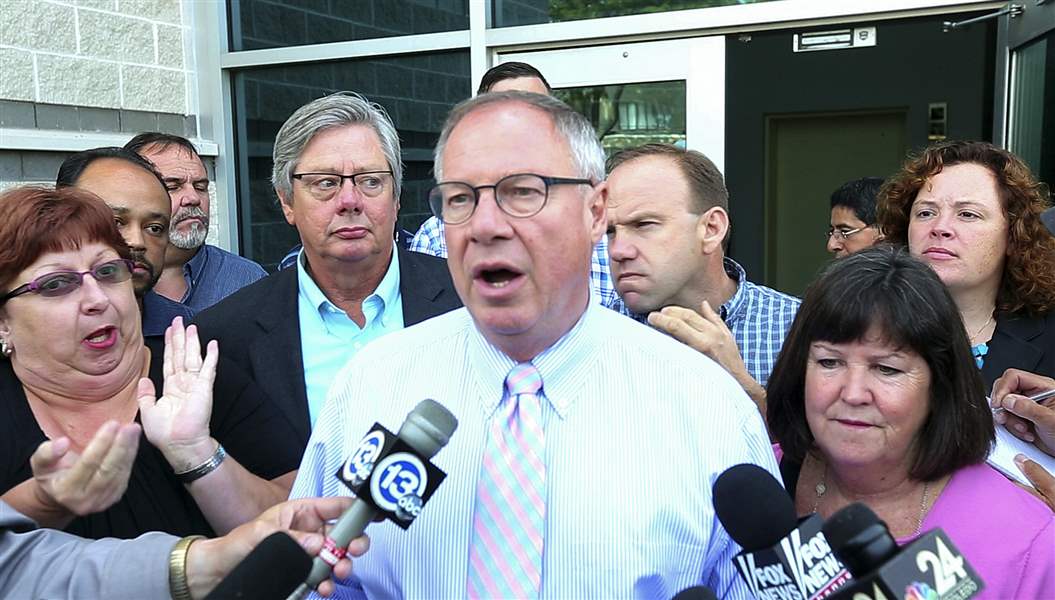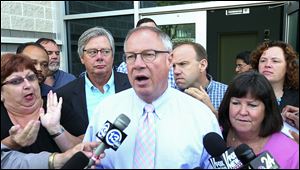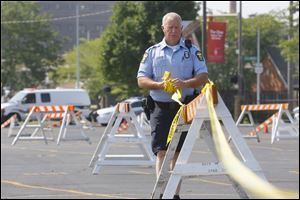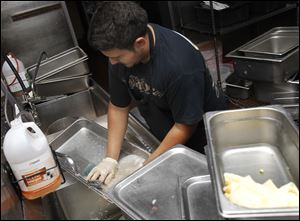
Toledo tap water deemed safe to drink
City lifts ban on drinking tap water
8/4/2014
Toledo Mayor D. Michael Collins announces that the Toledo water crisis is over during a news conference early today.
The Blade/Amy E. Voigt
Buy This Image

Toledo Mayor D. Michael Collins announces that the Toledo water crisis is over during a news conference early today.
The ban of drinking water in northwest Ohio was lifted early today, after tests of Toledo water showed safe levels of the toxin microcystin.
Toledo Mayor D. Michael Collins announced at a 9:30 a.m. news conference that all tests in the city showed non-detectable levels of the toxin, meaning that a ban of consumption of the water that had been in place since early Saturday morning was lifted.
“Our water is safe,” he said.
EXTRA EXTRA! eBlade special edition covering the end of the water crisis
CITY OF TOLEDO PRELIMINARY STUDY ON WATER CRISIS
To demonstrate his confidence, Mr. Collins finished the news conference by drinking a cup of Toledo water.
“Here's to you Toledo, you did a great job," he said.
RELATED ARTICLES:
■ Tips on when and how to flush water systems
■ Lucas Co. Commissioners vote to declare state of emergency
■ Ohio officials to investigate reports of price gouging during water crisis
■ Toledo-area hospitals prepare to return to city water
City leaders said the cost of dealing with the crisis was high, but said they did not yet know a dollar amount.
Residents were told to flush their water systems if they had not used water since Saturday. Directions on how to flush homes and businesses would be put on the city‘s Web site.
Those who had used water regularly since the ban could use the system safely immediately. City officials stressed that residents should not overburden the water system by everyone turning on their water at once.
The announcement meant water was safe, not that residents should go on a water binge. Area water stations were scheduled to close at 11 a.m.
The news followed a late night news conference where Mayor Collins announced that the advisory against drinking the city's tap water or returning to normal usage operations would stay in effect until further notice.

Toledo Police Officer J. Middleton breaks down the barriers and tape at 11:00 a.m. when water distribution at Central Catholic was closed.
That was despite test results from the Ohio Environmental Protection Agency and the U.S. Environmental Protection Agency that suggested the algae-induced toxin has probably dissipated to safe levels.
The level in two samples of water taken by city employees was found to be approaching 1.0 ppb in one of them and just over 1.0 ppb in the other, Mr. Collins said. While there is no state or federally mandated limit for microcystin, the potentially deadly toxin in a harmful form of blue-green algae known as microcystis, the World Health Organization has recommended that the drinking water concentration be kept at 1.0 ppb or less.
The latest tests performed by the Ohio EPA and the U.S. EPA had come back back negative, although those tests were performed differently.
Mr. Collins said the two neighborhoods were those samples were taken were East Toledo along Starr Avenue and Point Place along Summit Street.
A benefit from the weekend emergency was that the state and federal EPA and local officials all agreed on a single, uniform test.
Gov. John Kasich, and Ohio EPA Director Craig Butler, released statements after the ban was lifted. They both commended city, state, and federal leaders for their work.
”They made a big difference. Over the past two days we’ve been reminded of the importance of our crown jewel — Lake Erie — to our everyday lives. We must remain vigilant in our ongoing efforts to protect it,“ the governor said.
Mr. Butler said in part: ”In the days ahead, we will continue to work closely with Toledo and others to better understand what happened and support their effort to supply safe drinking water to its customers.”

Antonio Vasquez cleans dishes in the kitchen of El Vaquero at The Docks.
Microcystin is the toxin that breached an eight-step treatment process at the Collins Park Water Treatment Plant which had never failed to neutralize it in the past.
It is the same toxin which killed 75 people in a kidney dialysis center in Brazil in 1995, prompting a major investigation by the U.S. Centers for Disease Control and Prevention.
More chemicals, such as powdered activated carbon, have been added to the water-treatment process to bring down the levels inside the plant. Mr. Collins said today that the algae issue was one that needed more serious attention.
“We have not been good stewards of that natural resource,’ he said.
The Toledo-Lucas County Health Department said Saturday the toxin had been found in Toledo-area tap water at concentrations of 1.5 ppb to 2.5 ppb.
U.S. Rep. Marcy Kaptur (D., Toledo) told The Blade on Sunday night an undisclosed U.S. EPA official told her in passing during a conference call there was believed to be a spike as high as 3 ppb in tap water, three times the World Health Organization's recommendation.
Ed Moore, director of Public Utilities, said that the city could not have prevented what happened over the weekend, because algae bloomed right over the city‘s water intake plant.
”We are at it's mercy,“ he said. ”We were helpless.“